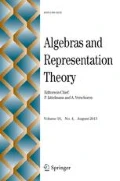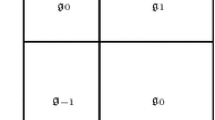Abstract
In this article, we are interested in some subspaces of the exterior algebra of a simple Lie algebra \(\mathfrak {g}\). In particular, we prove that some graded subspaces of degree d generate the \({\mathfrak {g}}\)-module \(\bigwedge ^{d}{\mathfrak {g}}\) for some integers d.
Similar content being viewed by others
References
Bourbaki, N.: Lie groups and Lie algebras. Chapters 4–6. Translated from the 1968 French original by Andrew Pressley. Springer-Verlag, Berlin (2002)
Charbonnel, J.-Y.: Projective dimension and the Commuting variety of a reductive Lie algebra. arXiv:2006.12942 (2020)
Author information
Authors and Affiliations
Corresponding author
Additional information
Presented by: Michela Varagnolo
Publisher’s Note
Springer Nature remains neutral with regard to jurisdictional claims in published maps and institutional affiliations.
Appendix A: Some Remarks on Root Systems
Appendix A: Some Remarks on Root Systems
Let β be in Π and X := Π ∖{β}. Set \({\mathfrak p}_{\mathrm {u}} := {\mathfrak p}_{\mathrm {u},X}\) and \(d := \dim \hskip .125em {\mathfrak p}_{\mathrm {u},X}\). The goal of the section is the following proposition:
Proposition A.1
-
(i)
Suppose Π of type Aℓ and X not connected. Then β = βs+ 1 for some s in {1,…, ℓ − 2},
Moreover, if 2d + n1 ≤ n then
-
(ii)
Suppose Π of type Bℓ or Cℓ and X not connected. Then β = βs+ 1 for some s in {1,…, ℓ − 2},
Moreover, if 2d + n1 ≤ n then
-
(iii)
Suppose Π of type Dℓ. If β = βℓ− 2 then 2d > n. If β is different from βℓ− 2 and X is not connected, then
Moreover, if 2d + n1 ≤ n then
-
(iv)
Suppose that Π is exceptional. If 2d ≤ n then X is connected.
We prove the proposition case by case. So, in the classical case, we suppose ℓ ≥ 3 and X not connected.
1.1 A.1 Type Aℓ
As X is not connected, m = 2 and β = βs+ 1 for some s in {1,…,ℓ − 2}. Then
If n − 2d − n1 ≥ 0 then
As s ≥ 1, the first inequality is possible only if ℓ ≥ 6. The second inequality is impossible since its right hand side is bigger than ℓ − 2 and s is at most ℓ − 2.
By the above equalities,
If the left hand side is nonnegative then
The first inequality is impossible since its right hand side is negative. The second inequality is possible only if ℓ ≥ 7 since s ≤ ℓ − 2. Moreover, it is not possible to have n ≥ 2d + n1 and n ≥ 2d + n2 since
whence Assertion (i) of Proposition A.1.
1.2 A.2 Type Bℓ or Cℓ
As X is not connected, m = 2 and β = βs+ 1 for some s in {1,…,ℓ − 2}. Then
If n − 2d − n1 ≥ 0 then
As s ≥ 1, the first inequality is possible only if ℓ ≥ 7. The second inequality is impossible since its right hand side is bigger than ℓ − 2 and s is at most ℓ − 2.
By the above equalities,
If the left hand side is nonnegative then
The first inequality is impossible since its right hand side is negative. The second inequality is impossible since
whence Assertion (ii) of Proposition A.1.
1.3 A.3 Type Dℓ
As X is not connected, β is different from β1, βℓ− 1, βℓ. If β = βℓ− 2 then X has three connected components and
In this case n < 2d. Suppose ℓ ≥ 5 and β = βs+ 1 for some s in {1,…,ℓ − 4}. Then
If n − 2d − n1 ≥ 0 then
As s ≥ 1, the first inequality is possible only if ℓ ≥ 8. The second inequality is impossible since its right hand side is bigger than ℓ − 4 and s is at most ℓ − 4.
By the above equalities,
If the left hand side is nonnegative then
These inequalities are impossible since s is positive and smaller than ℓ − 3, whence Assertion (iii) of Proposition A.1.
1.4 A.4 The Exceptional Cases
Set \({\mathfrak {l}}:={\mathfrak {l}}_{X}\), \({\mathfrak {d}} := {\mathfrak {d}}_{X}\). Then \(2d = \dim \hskip .125em \mathfrak {g}-\dim \hskip .125em {\mathfrak {l}}\). For each case, we give all the possible dimensions of \({\mathfrak {l}}\) when |X| = ℓ − 1.
-
(a)
The algebra \(\mathfrak {g}\) has type G2. Then X is connected, whence Assertion (iv) of Proposition A.1 for this case.
-
(b)
The algebra \(\mathfrak {g}\) has type F4. In this case n = 24 and
$$ \dim\hskip .125em {\mathfrak{l}} \in \{12,22\} \quad \text{whence} \quad 2d \in \{40,30\}$$and Assertion (iv) of Proposition A.1 for this case.
-
(c)
The algebra \(\mathfrak {g}\) has type E6. In this case n = 36 and
$$ \dim\hskip .125em {\mathfrak{l}} \in \{20,28,36,46\} \quad \text{whence} \quad 2d \in \{58,50,42,32 \}$$and Assertion (iv) of Proposition A.1 for this case since \({\mathfrak {d}}\) is simple of type D5 when 2d = 32.
-
(d)
The algebra \(\mathfrak {g}\) has type E7. In this case n = 63 and
$$ \dim\hskip .125em {\mathfrak{l}} \in \{27,33,39,49,67,79\} \quad \text{whence} \quad 2d \in \{106,100,94,84,66,54\}$$and Assertion (iv) of Proposition A.1 for this case since \({\mathfrak {d}}\) is simple of type E6 when 2d = 54.
-
(e)
The algebra \(\mathfrak {g}\) has type E8. In this case n = 120 and
$$\dim {\mathfrak{l}} \in \{36,40,52,54,64,82,92,134\} \text{ whence } 2d \in \{212,208,196,194,184,166,156,114\}$$and Assertion (iv) of Proposition A.1 for this case since \(\mathfrak {d}\) is simple of type E7 when 2d = 114.
Rights and permissions
About this article
Cite this article
Charbonnel, JY. On Some Subspaces of the Exterior Algebra of a Simple Lie Algebra. Algebr Represent Theor 25, 725–746 (2022). https://doi.org/10.1007/s10468-021-10042-0
Received:
Accepted:
Published:
Issue Date:
DOI: https://doi.org/10.1007/s10468-021-10042-0



